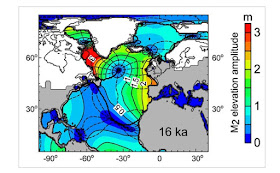Look almost anywhere, and thou shalt find.......
I have been looking at the Tenby and Pembroke geological memoir, edited by E.E.L.Dixon and published in 1921. This was of course the year in which HH Thomas gave his famous lecture on the Stonehenge bluestones, and denied the possibility that the monoliths could have been transported by ice. Thomas was one of the geological surveyors, and some of the notes in the chapter on superficial deposits may well have been written by him.
That's interesting, because in this memoir, as in the others relating to West Wales, a vast amount of evidence (collected by Thomas, Cantrill, Strahan, Dixon and Jones) is presented which shows that glacial deposits are widespread, and that erratic transport was not just possible but well documented. In the memoir, there is reference to erratics transported from Pembrokeshire to the Swansea area and to Pencoed in Glamorgan. Thomas knew that boulders could be carried by ice for at least two hundred miles -- and indeed he was perfectly familiar with big erratics of Scottish origin in Pembrokeshire -- and yet he deemed the transport of Stonehenge bluestones to have been impossible. So his bluestone lecture, and the paper that followed it in 1923, was designed for effect -- presented to antiquarians, not geologists. He wanted to tell a story, and I think he wanted notoriety and fame. Now where have we heard that before?
Ixer and Bevins have done exactly the same thing, of course, publishing the bulk of their recent articles about the bluestones not in the specialist geological literature, but in magazines read by archaeologists and the general public -- edited by archaeologists and presumably refereed by archaeologists too. Limited scrutiny, instant appeal......... and uncertain reliability.
On to the till. The surveyors do not always identify glacial deposits for what they are in in these memoirs -- we must recall that the term then in use was "boulder clay", not "till", and when described deposits were not particularly clay-rich, they often referred to them as "gravels" with faceted and striated erratics in them! I am quite certain that many of the deposits called "gravels" are in fact of glacial origin.
Caldey Island -- Sandtop Bay. On page 196 there is a record of what has to be fresh till, in a deep pipe in the NE corner of the bay.
https://brian-mountainman.blogspot.com/2011/08/glaciation-of-caldey.html
Lydstep Haven.There is a record (on page 201) of the submerged forest which was exposed in 1906, with a basal stony deposit under it, containing limestone and sandstone pebbles, chert and igneous rocks. The surveyors speculate that this material is "head", "mixed with some Drift debris". That sound to me like a till which has been subjected to some redistribution under cold climate conditions prior to the growth of the submerged forest. This is the classic Late Devensian scenario.
Low-res photo from David Evans, Pembvs Coast Photography, of the Black Mixen peninsula. The blackish lichens or algae on the rock surface probably explain the name.....
Draught, at the exit point of the Lydstep Valley, is referred to on p 200 as having a small patch of gravel and sand -- "evidently ancient" -- containing chert, grits, shales and ORS pebbles. The surveyors say it was being eroded. at the time of the survey. They say it is probably nothing to do with the raised beach because it has no head above it -- and I am convinced this is the first record of the Devensian till which I described in a recent post.
https://brian-mountainman.blogspot.com/2018/05/devensian-till-at-lydstep.html
On p 192 there is mention of the "Black Mixen" peninsula at Lydstep, which has to be the one which has the ancient till exposed on its neck, beneath cemented limestone breccia. Strangely, the surveyors make no mention of the cemented till.
Freshwater East -- there is a record of "strips of gravel" a few feet above the alluvium of the river valley. Origin uncertain.
On pp 199-200 there are many mentions of erratic boulders, including the seven at Flimston Church, which have been commandeered for use as headstones.
https://brian-mountainman.blogspot.com/2013/09/an-erratic-lesson-from-flimston.html
https://brian-mountainman.blogspot.com/2013/01/more-south-pembrokeshire-erratics.html
Bosherston Limestone plain -- drift with chert, ORS and igneous pebbles here and there von the surface and sometimes in limestone "pipes". Some igneous erratics are over 18" in diameter.
Flimston clay pits -- the surveyors remark upon the Tertiary quartz gravels with many white pebbles, but also upon the presence of "red gravel" containing ORS pebbles, chert, and faceted and striated pebbles including many of igneous origin. Again, this must be a relatively fresh till.
Freshwater West -- submerged forest north of Little Furzenip exposed in 1912, with peat and prostrate branches, stumps and roots, the latter embedded in "head". There is a stony red clay which is bleached to green-grey near the surface. Stones in this clay include igneous erratics. This deposit is separated from the submerged forest beds by a tenaceous blue clay up to 6" thick. (interestingly enough, the forest here has traces of human occupation, and it also contained the remains of a whale skull which is apparently preserved at the National Museum of Wales (Whales?)........
See also:
https://brian-mountainman.blogspot.com/2016/02/devensian-till-at-freshwater-west.html
Reference:
The Geology of the South Wales Coalfield. Part XIII: The Country around Pembroke and Tenby. Being an account of the region comprised in Sheets 244 and 245 of the map. By E. E. L. Dixon, B.SC, F.G.S. Memoirs of the Geological Survey, pp. 220. 1921.
Reference:
The Geology of the South Wales Coalfield. Part XIII: The Country around Pembroke and Tenby. Being an account of the region comprised in Sheets 244 and 245 of the map. By E. E. L. Dixon, B.SC, F.G.S. Memoirs of the Geological Survey, pp. 220. 1921.
































